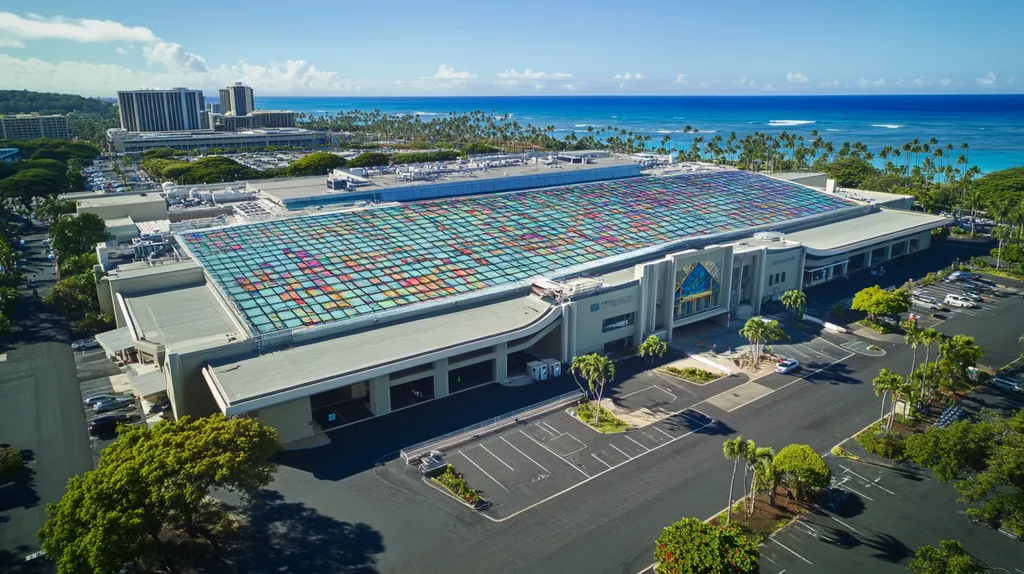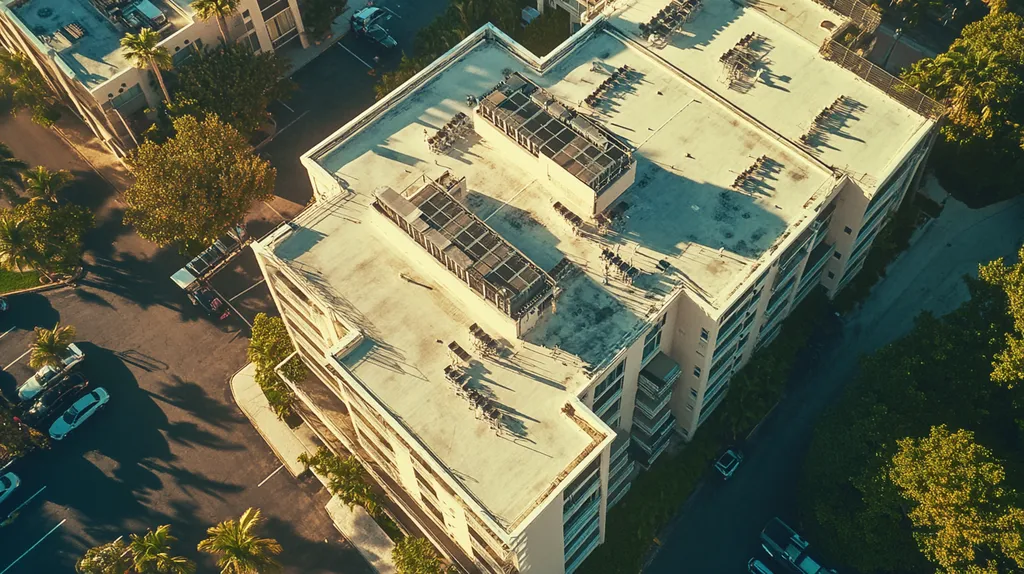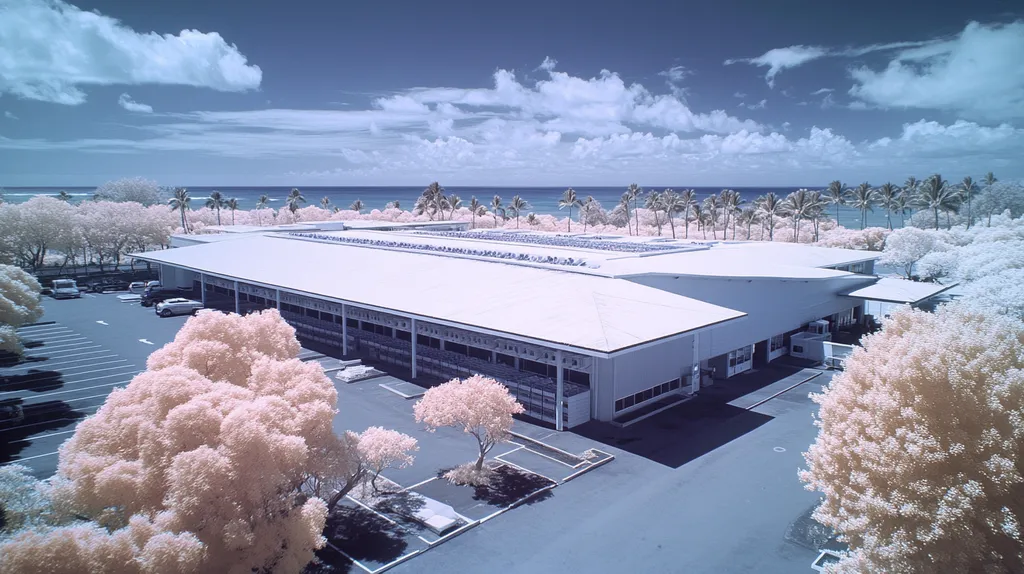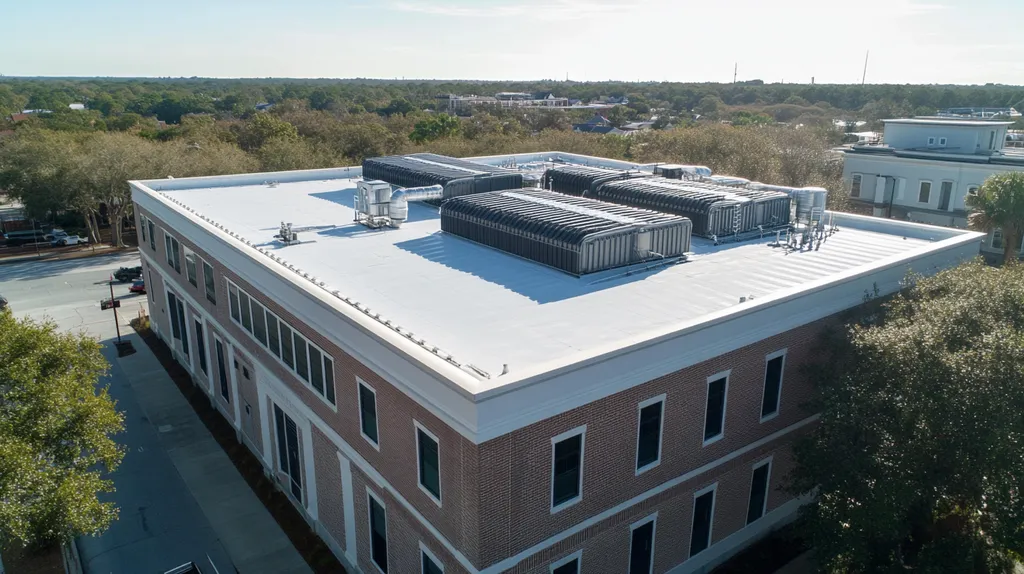Commercial building owners face a critical choice when selecting roof coatings, with studies showing that improper climate-based selection can reduce coating lifespan by up to 70% while doubling energy costs.
As extreme weather events increase in frequency and intensity, choosing the right protective coating has become more vital than ever for maintaining building integrity and controlling operational expenses.
This comprehensive guide examines the essential factors in matching coating systems to your local climate, from basic terminology through advanced selection criteria and common pitfalls to avoid.
SECTION 1: THE BASICS EXPLAINED
When it comes to protecting commercial buildings, roof coatings represent a critical line of defense against increasingly extreme weather patterns. Recent studies show that properly coated roofs can extend a roof’s lifespan by 10-15 years while reducing cooling costs by up to 35%. However, selecting the wrong coating for your climate can lead to premature failure and costly repairs.
What It Is (In Plain Language)
A roof coating is essentially a thick, waterproof layer that’s applied over your existing commercial roof. Think of it as a heavyweight raincoat designed specifically for your building’s climate challenges.
These coatings come in several formulations, including acrylic, silicone, and polyurethane. Each type offers different levels of protection against specific environmental threats like UV radiation, rain, or temperature extremes.
The type of roof on your facility, combined with your area’s climate and specific protection needs, determines which coating will perform best. (source: Rainville-Carlson)
Modern coatings can serve multiple functions simultaneously – waterproofing, reflecting sunlight, insulating against heat transfer, and even self-cleaning properties that prevent debris accumulation.
Why It Matters (To Your Building)
Proper roof coating selection directly impacts your building’s operational costs and maintenance requirements. An appropriate coating can reduce cooling expenses by reflecting up to 85% of solar heat that would otherwise be absorbed.
Beyond energy savings, coatings protect your roof’s underlying structure from deterioration. This protection prevents costly repairs and extends the time between full roof replacements.
Climate-appropriate coatings also help prevent moisture infiltration, which can lead to mold growth, decreased insulation effectiveness, and structural damage.
For facility managers, this translates to lower maintenance budgets and fewer emergency repairs, allowing for more predictable long-term planning.
How It Works
Roof coatings create a seamless, protective membrane that bonds directly to your existing roof surface. This membrane acts as a barrier against water, UV radiation, and temperature fluctuations.
The coating’s specialized polymers and additives work together to maintain flexibility through temperature changes, preventing cracks and separation that could compromise protection.
Reflective coatings work by bouncing solar radiation away from the building, while others focus on creating an impermeable barrier against moisture infiltration.
Different formulations utilize various chemical properties to combat specific environmental challenges, from high humidity to extreme temperature swings to intense UV exposure.
SECTION 2: PRACTICAL APPLICATIONS
Commercial roof coatings represent a critical investment decision that directly impacts building performance and operational costs. Studies show that properly selected and applied coatings can reduce energy consumption by up to 35% while extending roof life by decades. However, the key to achieving these benefits lies in understanding when, where, and how to apply these protective systems.
Common Uses & Examples
Modern roof coatings serve multiple critical functions across various commercial building types. White or “cool roof” coating systems have become especially popular in sunny regions, where they effectively deflect solar heat and reduce cooling costs.
Large retail facilities often employ reflective coatings to manage temperature control expenses in their expansive spaces. Manufacturing facilities frequently use chemical-resistant coatings to protect against industrial emissions and harsh environmental conditions.
Healthcare facilities typically choose antimicrobial coatings that resist biological growth while maintaining strict cleanliness standards. These specialized applications help maintain sterile environments while protecting the building envelope.
Energy-efficient coatings can significantly reduce operational costs while potentially qualifying buildings for valuable tax incentives and LEED certification points. (source: Roof Source)
When You Need It Most
The optimal timing for coating application depends on both environmental conditions and roof condition. Early warning signs like surface oxidation, minor leaks, or increasing energy bills signal the need for immediate coating consideration.
Climate patterns play a crucial role in application timing. Coatings should be applied during periods of moderate temperature and low humidity to ensure proper curing and adhesion.
Regular roof inspections can identify the ideal application window before serious deterioration occurs. This proactive approach prevents costly emergency repairs and extends the overall lifespan of the roofing system.
Buildings in areas with extreme temperature fluctuations should schedule coating applications during transition seasons to ensure optimal performance.
Interactions With Other Systems
Roof coatings must work in harmony with existing roofing components to provide maximum protection. Understanding these interactions prevents compatibility issues that could compromise system integrity.
Different coating types interact uniquely with various roof membranes. Silicone coatings generally bond well with most substrates, while some acrylics may require specific primers for proper adhesion.
HVAC systems and rooftop equipment create unique challenges for coating applications. Proper detailing around these penetrations is essential for maintaining a continuous protective barrier.
The coating system should complement existing drainage patterns and not interfere with water flow. This consideration becomes especially important on low-slope roofs where proper drainage prevents ponding water.
SECTION 3: KEY TERMINOLOGY DECODED
In commercial roofing, misunderstanding technical terms can lead to costly mistakes and premature system failures. Industry studies show that up to 40% of roof coating failures stem from improper product selection due to terminology confusion. Understanding the language of roofing isn’t just about communication – it directly impacts building performance, energy efficiency, and long-term maintenance costs.
Essential Terms Explained
Reflectivity and emissivity form the foundation of coating performance metrics. Reflectivity measures the percentage of solar radiation bounced away from the roof surface, while emissivity indicates how effectively the surface releases absorbed heat.
Weathering resistance describes a coating’s ability to maintain its protective properties when exposed to UV radiation, precipitation, and temperature fluctuations. This factor becomes especially critical in regions experiencing extreme seasonal changes.
Surface preparation terms like “profile” and “substrate condition” indicate how the existing roof must be treated before coating application. Proper surface preparation can account for up to 75% of a coating system’s success.
Understanding seasonal weather patterns and roof material composition helps determine optimal coating selection and application timing. (source: Inland Coatings)
Industry Jargon Translated
Chemical composition terms define coating categories and their specific applications. Elastomeric coatings stretch and recover with temperature changes, while thermoplastic coatings offer superior chemical resistance.
Application-specific terminology includes “wet mil thickness” and “spread rate,” which determine proper installation procedures. These measurements ensure adequate protection while optimizing material usage.
Performance indicators like “elongation” and “tensile strength” describe a coating’s ability to withstand physical stress without failing. Higher values typically indicate better durability and longer service life.
Environmental terminology such as “cool roof rating” and “solar reflectance index” helps quantify energy efficiency benefits and potential utility cost savings.
Measurement & Units Simplified
Coverage rates typically appear in gallons per square (100 square feet). This measurement helps calculate material requirements and project costs accurately.
Dry film thickness, measured in mils, indicates the final protective layer depth after curing. Most commercial applications require between 20-30 mils for optimal performance.
Temperature requirements include both ambient and surface readings in Fahrenheit. These measurements ensure proper curing and adhesion during application.
Performance metrics often include percentages for solar reflectance and thermal emittance. These values directly correlate to potential energy savings and roof surface temperature reduction.
SECTION 4: DECISION FACTORS
When selecting commercial roof coatings, seemingly minor decisions can have major financial implications spanning decades. Industry data shows that improper coating choices can double energy costs and reduce roof lifespan by up to 50%. Making informed decisions about coating selection requires careful evaluation of multiple factors including initial investment, long-term performance requirements, and durability needs specific to your climate zone.
Cost Considerations
Initial coating costs typically range from $2-8 per square foot, but focusing solely on upfront expenses often leads to costly mistakes. Installation quality and material grade significantly impact long-term performance and maintenance requirements.
The total cost of ownership must factor in energy savings, maintenance intervals, and potential warranty coverage. Premium coatings may cost more initially but often deliver superior returns through reduced cooling costs and extended service life.
Labor costs represent 40-60% of most coating projects, making proper installation critical. Selecting materials that require specialized application techniques can increase initial costs but may provide better long-term value.
Consider coating thickness requirements, as insufficient coverage leads to premature failure. Single-coat systems may seem economical but often require more frequent reapplication than multi-coat alternatives.
Performance Trade-offs
White or ‘cool roof’ coating systems can significantly reduce cooling costs while extending roof life through enhanced UV protection. These reflective systems can qualify buildings for valuable energy efficiency tax incentives and LEED certification points. (source: RoofSource)
Chemical resistance often competes with flexibility in coating formulations. Buildings with industrial emissions require different protective properties than those primarily concerned with thermal stability.
Weather resistance capabilities vary significantly between products. Coatings optimized for UV protection may offer reduced performance against standing water or extreme temperature cycling.
Application windows and cure times affect project scheduling and can impact building operations. Fast-curing products may sacrifice some performance characteristics for installation convenience.
Lifespan & Durability Factors
Expected service life varies dramatically based on environmental exposure and maintenance practices. Premium coatings typically last 15-20 years with proper maintenance, while economy options may require replacement within 5-7 years.
Adhesion strength and substrate compatibility directly impact coating longevity. Poor bonding leads to delamination and premature failure, particularly in areas with extreme temperature fluctuations.
Impact resistance becomes crucial in areas prone to hail or frequent maintenance traffic. Higher mil thickness generally provides better impact protection but increases material costs.
UV stability and color retention affect both appearance and performance. Degraded coatings lose reflective properties and protective capabilities, leading to increased energy costs and potential substrate damage.
SECTION 5: COMMON CHALLENGES
Commercial roof coating failures cost property owners millions annually in repairs and energy waste. Recent industry data shows that over 60% of coating problems stem from improper material selection for local climate conditions. With extreme weather events increasing, understanding and addressing common coating challenges has become critical for protecting building investments and maintaining operational efficiency.
Frequent Problems & Solutions
Poor adhesion represents the leading cause of coating failure, often resulting from inadequate surface preparation or applying coatings in non-optimal conditions. Thorough cleaning, proper primers, and appropriate application temperatures are essential for achieving maximum bond strength.
Ponding water creates significant challenges for many coating systems, leading to deterioration and eventual leaks. Ecodur coatings demonstrate superior resistance to standing water compared to traditional silicone or acrylic alternatives, making them ideal for problematic low spots. (source: Castagra)
UV degradation accelerates coating breakdown, particularly in high-altitude or southern regions. Selecting coatings with enhanced UV stabilizers and maintaining proper thickness during application helps prevent premature aging.
Temperature cycling causes coating expansion and contraction, potentially leading to cracks and separation. High-quality elastomeric formulations provide the flexibility needed to accommodate these movements while maintaining protection.
Warning Signs To Watch For
Surface checking or crazing often appears before major coating failures occur. These small cracks indicate the coating is losing flexibility and requires immediate attention to prevent water infiltration.
Discoloration or chalking signals UV degradation and reduced protective capabilities. Regular inspections should focus on areas receiving maximum sun exposure, as these typically show damage first.
Blistering or bubbling indicates trapped moisture beneath the coating, which can lead to adhesion loss and substrate deterioration. Early detection allows for targeted repairs rather than complete replacement.
Edge lifting or shrinkage around penetrations suggests material stress or improper initial application. These areas require prompt attention to maintain the coating’s waterproof integrity.
Preventative Approaches
Establishing comprehensive maintenance protocols helps identify potential issues before they become major problems. Schedule regular inspections focused on high-stress areas and common failure points.
Maintaining detailed records of coating performance and environmental conditions helps optimize future material selections. Track temperature extremes, rainfall patterns, and UV exposure to inform coating choices.
Installing additional drainage solutions where ponding occurs can extend coating life significantly. Proper slope and drainage prevent water accumulation that degrades even the most resilient coatings.
Creating climate-specific application guidelines ensures optimal installation conditions. Consider seasonal weather patterns when scheduling coating work to achieve maximum adhesion and durability.
SECTION 6: NEXT STEPS & RESOURCES
The increasing frequency of extreme weather events has made proper roof coating selection more critical than ever. Studies show that coating failures cost commercial property owners millions annually in repairs, energy waste, and business disruption. Understanding available resources and taking systematic steps toward implementation can mean the difference between a robust, long-lasting solution and a costly mistake.
Questions To Ask Providers
Begin by requesting detailed information about the provider’s experience with your specific building type and local climate conditions. Ask for documentation of completed projects in similar environments and their performance over time.
Inquire about their surface preparation protocols and quality control measures. The best coating system will fail without proper substrate preparation and application procedures.
Request specifics about warranty coverage, including what environmental conditions or maintenance requirements could void protection. Understanding these limitations helps prevent unexpected expenses.
Discuss their maintenance recommendations and inspection schedule. Regular professional assessment can identify potential issues before they become major problems.
Industry Standards & Guidelines
Major coating decisions should align with standards from recognized organizations like ASTM International and the National Roofing Contractors Association (NRCA). These guidelines provide benchmarks for performance and application procedures.
Local building codes often specify minimum requirements for reflectivity, fire resistance, and wind uplift resistance. Ensure your chosen coating meets or exceeds these standards.
Light-colored, reflective materials offer superior performance in most climates, reducing energy costs while extending roof life. Proper material selection based on local conditions significantly impacts long-term durability and performance. (source: Cobex)
Energy Star and Cool Roof Rating Council (CRRC) ratings provide valuable data about coating performance under various conditions. Use these metrics to compare options objectively.
Further Learning Simplified
Take advantage of educational resources offered by industry associations and manufacturers. Many provide free technical bulletins and online training modules focused on coating selection and maintenance.
Consider joining professional organizations that focus on commercial roofing and building envelope protection. These groups often share valuable case studies and best practices.
Attend industry trade shows and seminars to learn about emerging technologies and application techniques. These events provide opportunities to discuss solutions with experienced professionals.
Document your coating project thoroughly, including environmental conditions during application and subsequent performance. This information proves invaluable for future maintenance and replacement decisions.
The Bottom Line
With extreme weather events increasing by 40% over the past decade, selecting the right roof coating for your climate has never been more critical for building protection and operational costs.
Studies consistently show that climate-appropriate coatings can extend roof life by 15-20 years while reducing cooling costs by up to 35%, making this decision a cornerstone of effective facility management.
The key lies in matching coating characteristics to local environmental challenges, from UV exposure to temperature swings to moisture levels.
Property owners who invest time in understanding their climate needs and working with qualified providers typically see double the performance lifespan compared to those who choose based on cost alone.
Moving forward, regular inspection protocols and climate-specific maintenance plans will become essential as weather patterns continue to intensify.
FREQUENTLY ASKED QUESTIONS
Q. What is a commercial roof coating?
A. A commercial roof coating is a thick, waterproof layer applied over existing roofs. It protects against weather elements and can significantly extend the roof’s lifespan while reducing energy costs.
Q. When should I apply a coating to my commercial roof?
A. Apply a coating when you notice early signs of wear, like oxidation or leaks. Timing also depends on climate conditions; moderate temperatures are ideal for application.
Q. What do terms like reflectivity and emissivity mean for commercial roofs?
A. Reflectivity is how much solar radiation is bounced away, while emissivity indicates how efficiently heat is released. Both metrics affect energy efficiency and cooling costs.
Q. What is the cost of commercial roof coatings?
A. Initial costs typically range from $2-8 per square foot, but long-term savings from energy efficiency and durability can offset this investment significantly.
Q. What common challenges affect industrial roofs with coatings?
A. Common challenges include poor adhesion, UV degradation, and ponding water. Each requires specific coatings or maintenance practices to prevent long-term damage.
Q. How can I choose the right coating for my climate?
A. Consider local weather patterns, temperature extremes, and UV exposure. Selecting a coating designed for your area’s climate can drastically improve its effectiveness and longevity.
Q. What should I ask a roofing contractor about coatings?
A. Inquire about their experience with your building type and local climate. Ask for documentation of past work and details on surface preparation and warranty coverage.











